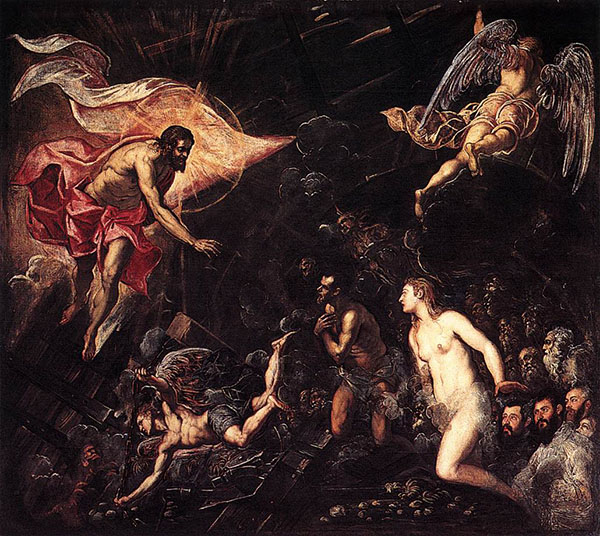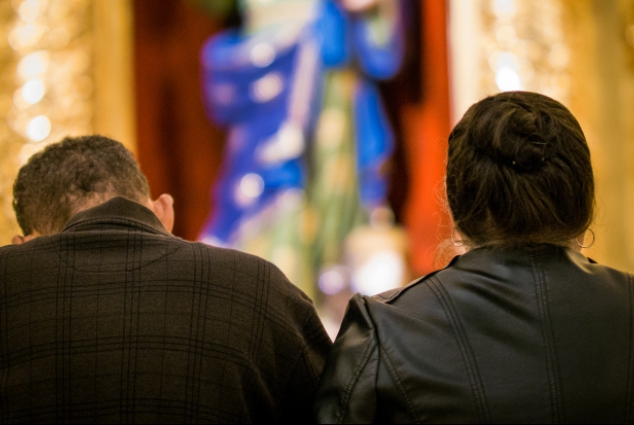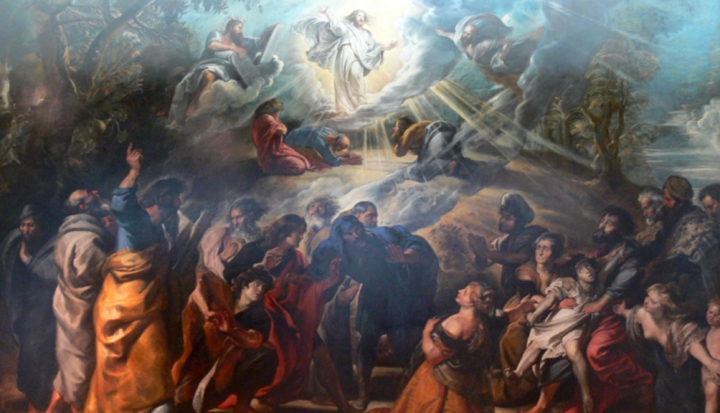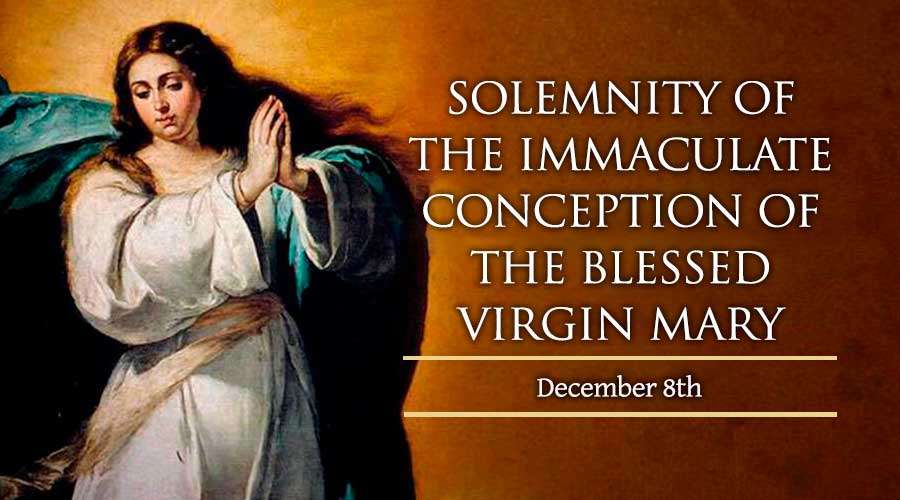A Sunday dogma
Those who attend Mass on Sundays, after listening to the homily of the priest, take part in praying the Creed, that is, they recite aloud the list of the articles of faith, which a Catholic has to believe in, in order to be united to the teachings of the Church.
But, often, they do so mechanically or with routine, such that they do not pay much attention to what they are saying. And this is how they do not take much notice of one particular article in the list of the dogmas of faith, which they profess they believe in, that is rather strange and disturbing. It is that article which affirms: “I believe in Jesus Christ, who was crucified, died and was buried; he descended into hell.”
If, all of a sudden, someone were to ask us if we believe that Jesus has been to hell, we would certainly and firmly answer no. However, come Sunday, once again, we proclaim it unhesitatingly and with all naturalness. What do we really want to affirm with this article of the Creed?
The place of despair
Dante recounts in his Divine Comedy that, in a vision he had one day, he reached the entrance to hell, and he saw a big sign with an appalling inscription, meant for all those who were entering it: “May those who enter this place abandon all their hope.”
It is true, and this is what the Church teaches us: hell is a definitive state, and once one enters it, there is no turning back at all. So, does it mean that when Jesus Christ went up to heaven, he transgressed this eternal law?
And since hell is the place destined for the damned, that is, for those who during their existence rejected God with a life of sin, then how could Jesus have been there, when in fact, as the letter to the Hebrews affirms (4: 15), he never committed sin?
Besides, theology teaches us that hell is the absolute absence of God. Therefore, Jesus Christ, who is God himself, could not possibly have been there, since if he had reached hell carrying the very God, hell would have become heaven.
So, did Jesus Christ descend into hell or not? Inevitably, we have to answer yes, since it is a dogma of faith proposed to us by the Church.
Thus, we see that there is something more important than memorizing and knowing the truths of our faith by heart. We have to understand their deep meaning.
The memory of Black Saturday
Any Christian knows well the events we commemorate on Good Friday and Easter Sunday. However, very few would be able to explain the occurrence which the Church commemorates on Black Saturday.
They would know that, liturgically, it is an empty day, in which Masses cannot be celebrated; nor could baptisms and weddings take place. At most, they will say that it is a day of mourning on account of the death and burial of Christ. But nothing more.
And yet, the Church appoints to this day the dogma of “Christ’s descending into hell.”
This forgotten truth does not arouse any interest neither in preaching nor in catechesis, to such an extent that many Christians, in fact, are not familiar with it, or even find it strange. But it constitutes such a fundamental pillar in our faith. With it, the Church wants to express two realities that are for us crucial to understand the Christian doctrine.
When the earth was flat
Let us begin by saying that “hell” in “He descended into hell” is not the “hell” which, according to Christian theology, is the state or place of those who are condemned for all eternity. Hell, in the Creed, was the place where, as the people of Israel in the years of pre-Christianity believed, those who died went.
Indeed, the Jews in the Old Testament had an image of the cosmos that was very different from ours. They represented it as an enormous, flat, and circular disk, surrounded by the immense waters of the ocean. It rested on four columns, which sank into the abyss.
Over the space was the firmament. It was a solid cupola, above which, it was believed, there was water; and it served as a vault to separate the waters from below. From this cupola hanged the sun, the moon, and the stars. For rain to come down, the doorways from above would be opened, and thus water fell on the earth.
The third stratum of this cosmos was the place called in Hebrew Sheol, the dwelling place of the dead, the underworld, located under the earth. There, all the deceased went, without exception.
When the word Sheol had to be translated into Greek, the word Hades was used. And, later, when it passed to Latin, it was translated as infernus, which precisely means that: “lower place, underworld.” These words, therefore, indicate the same reality.
The Sheol, dwelling place of the dead
The Hebrews had hardly developed the doctrine pertaining to the afterlife. For this reason, the Bible says little about Sheol or the infernus, hell.
People believed it was found under the earth, which explains why they spoke about “descending” into Sheol, and enveloped in darkness, since light was a legacy only of the living. There, nothing is heard, not even the voices of people, just absolute silence.
Whoever went down to Sheol could never return. Anyone who had gone past the frontiers of life, ended up there in that dark and caliginous region. This tenebrous dwelling place of the dead was an inevitable final destination for all men indiscriminately, whether good or bad.
The Bible gave the enigmatic name of refaím (=the impotent ones) to the inhabitants of the Sheol, since they subsisted there as in a flaccid and weakened state, with an ephemeral and somnolent existence. There, they did nothing; they did not enjoy anything; they could not praise God nor have any contact with him. They were living shadows.
True, but difficult to believe
Well then, it was not easy for believers of all ages to admit that Jesus ——being God, with his power and divine condition—— perished like any ordinary mortal, and had experienced Sheol.
Among the first Christians, some even denied that Jesus had a real, authentic and mortal body like ours; it was enough for them to sustain that his body was apparent, as though it were outer clothing, a garment that covered his divine person.
Those who defended this heresy were called “Docetists” (from the Latin verb doceo, which means “to seem,” “to appear like”). With an apparent body, it was logical that Jesus could not really die. At least, not as any human being would.
In this way, they wanted to exalt the figure of the Lord even more, as what presently happens among the Muslims, who consider Jesus as a great prophet, who think that there could not have been a death as is narrated in the Gospels. According to the Koran, on Good Friday, in the midst of all the confusion, the Roman soldiers made a mistake, took hold of Simon of Cyrene, and crucified him, while Jesus escaped.
Therefore, we understand why, in the Church, the idea of Christ humanly dead could not be imposed easily.
A truly dead person
The danger was great because, if Jesus had not truly died, then neither had he resurrected. And, therefore, our salvation would not have been wrought, and we would still remain the same as before.
Thus, they saw the need to inscribe this belief as a dogma, which was defined in this manner: “I believe that Jesus Christ died and was buried.” And to leave no room for any doubt that his death was real, the phrase was added: “He descended into hell.”
The phrase “He descended into hell,” as we understand, is composed of concepts that are no longer ours. Now that we know that the earth is not flat but round, neither do we believe that the dead go down to a “lower place.” However, the truth of faith is unalterable. With this, we only mean that Jesus “truly” died, that he went through the humiliation of dying, separated from this life, excluded from the world that continued to live.
Thus, when we Catholics profess our faith in that Jesus Christ descended into hell, we simply wish to say that he remained in the real state of death, that he reached the extreme limit of his self-abasement, that he really and deeply touched death.
The sound of the broken chains
But there is a second aspect that this phrase wanted to underline: the salvation of all the just men of the Old Testament.
It is true: all the good, the just, the saints, who had died before Jesus Christ were in “hell” or in Sheol. And no one could enter “into heaven,” in the place of salvation, before Christ, because as St Paul tells us, he is the first in resurrecting from among the dead, the first among brothers, the first in everything (Col 1:18). Everyone in “hell” was waiting and hoping that the Redemption of Christ take place.
When Christ died, he went down, therefore, to seek out the just men, to give them the good news, and to lead them to Paradise. Christ inaugurated heaven; all those who had been worthy of salvation before his coming also followed him into heaven.
The chains, which, according to Peter’s discourse on Pentecost Sunday, had bound Christ and all the defunct in Sheol (Acts 2:24), had been broken forever.
The Bible says it
Peter himself, in his first letter, writes about this topic, although in a manner that is concealed and confused, when he relates, “Christ died as humans do, but was raised to life by the Spirit”(3:18-19). And, much later, he adds: “The Gospel has been preached to many who are now dead. As humans they received a deadly sentence, but through the Spirit they shall live for God” (4:6).
Matthew also alludes to this liberation, between the Death and Resurrection of Christ, when he narrates that, no sooner had Jesus died than “tombs were opened, and several holy people who had died were raised to life. They came out of the tombs after the resurrection of Jesus, entered the Holy City” (eschatological, that is, “Heaven”) (Mt 27: 52-53).
Likewise, John, in the Book of Revelation, presents Jesus Christ as “the living; I was dead but now I live forever and ever, and I have the gates of the dead and of Hades” (1:18).
In the dwelling place of the dead, the life
The “descent” of Christ into hell, therefore, has a colossal message. All those who had lived before Christ, to whom the Gospel had never reached, and who had never heard speak about the Redeemer, could also be saved.
All periods of history have been sanctified, starting with Adam’s time. Hence today, for us, who know better than before the oldness of our humanity, this doctrine has greater dimensions.
For those of us who came after, the dogma affirms that Christ passed through that gate which terrifies us most: the gate of death, which before was “the hell,” and which was destroyed by Christ. All the fear of the world was placed on this. But now, Sheol has been overcome. Death is no longer the same as before, because life is in its midst.
The gates of death had been permanently opened for those who came after, as well as for those who had died previously.
The legend of Adam
In Jerusalem, at the entrance of the Holy Sepulcher Church, there is a grotto called “the grotto of Adam.” The first Christians, those who loved to commemorate the truths of faith in a rather synthetic and folkloric way, had created a legend around this.
They said that it was the place where Adam and Eve lived, and in that place, they were buried.
Well then, this grotto is found exactly under the rock of Calvary, where the wood on which Jesus was nailed stood. According to this legend, when Christ died on the cross, his blood flowed through the crevices of the rock that had cracked on account of the earthquake, and then fell on the remains of Adam, who was buried there, and bathed his remains.
With this narration, they wished to point out that for Adam, who represents the first man who sinned, and whoever he was, also was the object of salvation. With him, redemption started.
That is why, in many representations of the crucifix, there is a skull at the feet of Jesus: that is the skull of Adam, receiving the first drops of the blood of Redemption.
Old-fashioned but very rich dogma
The “descent into hell” is a doctrine that has a fundamental importance for the understanding of the Christian faith.
As we enunciate it today, it is expressed in obsolete and outdated attributes. Nevertheless, it preserves in its original sense the precious truth that Christ, by truly dying, destroyed the death of yore. And from then on, no person, regardless of the period he lived, remains outside the plans of the salvation by Christ; this means that no one is excluded from the possibility of salvation which Christ offers to each one.
Before Christ, no one had chronological privileges. Neither those born before, nor those born after, nor his contemporaries. All periods of history——from the time the first spark of humanity appeared in primitive man two million years ago, until the last one who would traverse our universe——all have been sanctified.
When Clovis, barbaric king of France, was converted into Christianity in the year 496, he would receive catechetical instruction from the bishop Remigius. One day, listening to the story of the arrest and the Passion of Jesus, he exclaimed with the impetus characteristic of new converts: “Oh, Lord! If I had been there with my French army, I would have prevented this from happening!”
But such pretension of Clovis is pointless. It is not necessary to have been born in another era. We will always be in time to extend help to Jesus, to listen to him, to commit ourselves to his cause, as did the others who trudged this world before him.
We can be born in whatever century. Christ’s descending into hell sanctified all men of all times.












